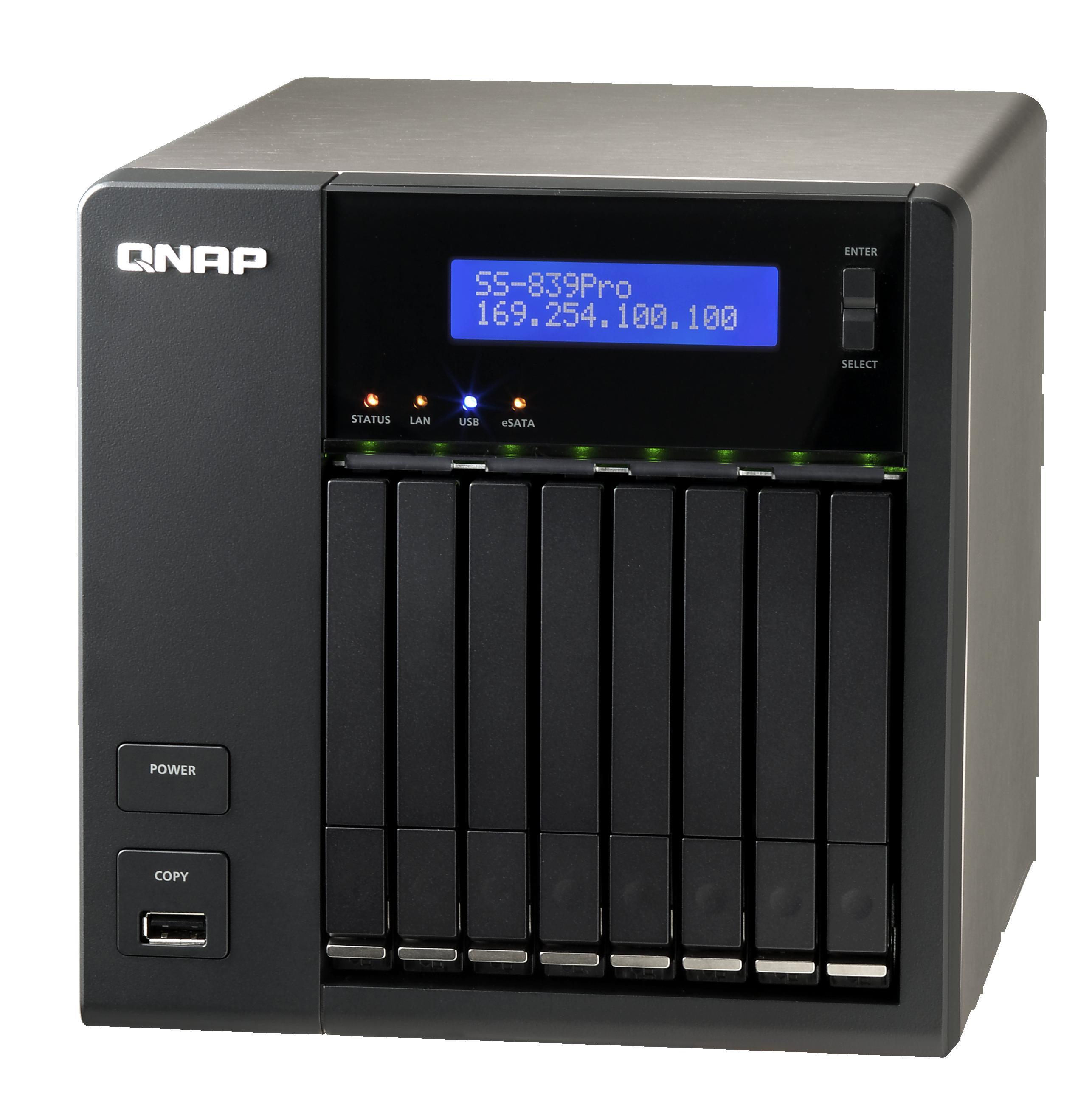QNAP Offers World's Smallest NAS
QNAP's new SS-839 Pro Turbo is slated to be the world's smallest 8-bay.
QNAP Systems today is claiming to offer the "world's smallest 8-bay" with its new SS-839 Pro Turbo network-attached storage (NAS) server. The company backs its claim by providing support for eight 2.5-inch hard drives or solid state disks (SSD), and a storage capacity of up to 4 TB (or up to 500 GB per drive). To expand the NAS even more, QNAP also included two eSATA and five USB ports, allowing end-users to add extra external backup storage if needed. According to QNAP, the SS-839 Pro Turbo is targeted for business owners, consuming low power (34 W with all 8 bays installed) and remaining extremely quiet while providing high performance, stability, and scalability.
Under the hood, the SS-839 Pro features Intel's Atom N270 CPU running at 1.6 GHz, 2 GB DDR2 RAM, 128 MB Disk on Module (DOM) flash memory, and 2 gigabit RJ-45 Ethernet ports. The server also supports RAID 0, 1, 5, 6, 5 + hot spare, single, and JBOD, Online RAID Capacity Expansion, and Online RAID Level Migration. On the security front, the server uses AES 256-bit volume-based encryption: end-users must provide the encryption password in order to access the drives.
Outside the hardware specifications, the SS-439 Pro Turbo can not only act as a network server, but also as an FTP sever and a web server using built-in applications such as phpMyAdmin, Joomla, MySQL/ SQLite, and an editable php.ini. As a printer server, the NAS supports up to three printers; performing as a Surveillance Station, the NAS can support up to four IP-based cameras. QNAP said that end-users could add additional software applications such as a mail server provided by XDove, a Wordpress system or other environments. Additional features include Wake on LAN, automatic policy-based IP blocking, network share status report, instant SMS and email alert, and more.
According to QNAP, the SS-839 Pro Turbo is compatible with Windows, Mac, Linux, and UNIX operating systems. But is this really the "world's smallest 8-bay" NAS? Based on the specs, the overall size of the server is 6.97 (H) x 7.09 (W) x 9.25 (D) inches.
Currently, QNAP has not provided pricing and availability at this time.
Get Tom's Hardware's best news and in-depth reviews, straight to your inbox.

Kevin Parrish has over a decade of experience as a writer, editor, and product tester. His work focused on computer hardware, networking equipment, smartphones, tablets, gaming consoles, and other internet-connected devices. His work has appeared in Tom's Hardware, Tom's Guide, Maximum PC, Digital Trends, Android Authority, How-To Geek, Lifewire, and others.
-
jeffunit The intel atom doesn't have ecc. Not so smart for a NAS to lack ecc, as all data flows through memory.Reply
If the AES encryption isn't done with dedicated hardware, but done with the atom, it is sure to slow everything down.
Sure looks cute though...
-
08nwsula jeffunitThe intel atom doesn't have ecc. Not so smart for a NAS to lack ecc, as all data flows through memory.If the AES encryption isn't done with dedicated hardware, but done with the atom, it is sure to slow everything down.Sure looks cute though...Reply
you almost always take a performance hit when size becomes more important. You would have to be really pressed for floor space to take advantage of this thing. Super small business anyone? -
WheelsOfConfusion 08nwsulayou almost always take a performance hit when size becomes more important. You would have to be really pressed for floor space to take advantage of this thing. Super small business anyone?Then again, VIA's Nano features hardware for full AES encryption and generally better performance than the single-core version of the Atom, using only slighting more power and a little bit more heat. It also has ECC.Reply -
rockerrb I don't understand why anyone would bother making a NAS with only 2.5" drives when you can get much more storage capacity out of bigger, desktop hard drives. I don't understand how a physical footprint would be a factor in someone wanting to buy a NAS.Reply -
jeffunit rockerrbI don't understand why anyone would bother making a NAS with only 2.5" drives when you can get much more storage capacity out of bigger, desktop hard drives. I don't understand how a physical footprint would be a factor in someone wanting to buy a NAS.Reply
That is a very good point. I have an article that will be published real soon now on tomshardware.com about how to build your own NAS, including examples of two I build. They both have 6 3.5" drives in a raid-5 array. 3.5" drives are *much* cheaper than 2.5" drives.
Of course, they do use a bit more power... -
matt2k jeffunitI have an article that will be published real soon now on tomshardware.com about how to build your own NAS, including examples of two I build.Reply
sounds good, i've been wanting to build a NAS system for a while now, will be looking out for that article. -
Spanky Deluxe rockerrbI don't understand why anyone would bother making a NAS with only 2.5" drives when you can get much more storage capacity out of bigger, desktop hard drives. I don't understand how a physical footprint would be a factor in someone wanting to buy a NAS.Reply
They do this because of the lower power requirements. 34 watts with 8 drives in is pretty darned impressive. Also, this would be ideally suited for things such as heavy database access. A company might want to put in 8 SSD drives (which pretty much all come in 2.5" sizes). That would give some amazing seek times and truly superb performance for a database.
Of course, while the typical user on Toms' might very well have an interest in NAS - they're usually more interested in it for the sheer amount of data storage you can get and so would be far more interested in 8 2TB 3.5" drives - I know I fit that category. However, there is a definite market out there for this kind of server. -
rockerrbI don't understand why anyone would bother making a NAS with only 2.5" drives when you can get much more storage capacity out of bigger, desktop hard drives. I don't understand how a physical footprint would be a factor in someone wanting to buy a NAS.Reply
Perhaps for a single person business, one that just is starting out, or a business of 2-3 office cubicles, that needs a web and print server. Often newer companies don't have the $$$ to spend on large machines.
They often don't have the $$$ neither to spend on security. A small server like this is easier stolen, but also easier overlooked.
Hide it in a closet or somewhere in the drawers of a desk, and it'll be there unnoticed!
I agree the Atom is far from a good processor for the job!
Perhaps good enough to stream data across a gigabit network, but not good enough to start with ?Active webpages?(I forgot the name in English for it, I mean webpages that one can visit, that eg: have a search field. After the search term has been send to the server, the server needs the computing power to see where on the storage space the term is been found). -
fozzyfozborne This server tops out at 4TB of storage, but wouldn't two 2TB 3.5" drives use less power, cost less, and have a smaller footprint?Reply
Let's say brand X has 500GB laptop drives for $95 each. That's + 8 x $95 or $760 + . Also the 2TB drives are ecodrives that can spin down to 5400RPM to save power so the comparison of 2 2.5" drives vs 2 3.5" drives wouldn't be that great. Along with that, a NAS with 1 SATA controller would most likely cost a substantial amount less than one with 4.
That said, an 8 drive NAS would have better average performance than one with 2 but gigabit networking is limited to around 100MBps and a single modern drive is capable of 85MBps so that's pretty much irrelevant.
Also, what's the likelihood that eight drives are going to work perfectly forever? I'd say a heck of a lot less than two drives working together.
Hey, just my 2 cents, but it seems as though QNAP made a large error in judgement. -
spazoid fozzyfozborne your post is quite flawed.Reply
First, eco drives do not spin down. They're running at a constant 5400 RPM.
Second, this unit probably only has 1 controller. This controller offers possibilities beyond what would make sense with in a controller with only 2 sata connections, ie raid-5, 6, 5E.
Third, gigabit is not limited to 100 MBps, but 125MBps in theory, and in reality closer to 115MBps depending on the quality of your network equipment.
Fourth, the likelyhood of a drive working perfectly forever, is, and always will be, equal to zero. All drives will fail, eventually. The best thing you can do, is to minimize the probability of unrecoverable dataloss and, if it is important, maximize data availability, in which case more drives is often better than fewer drives, if the appropriate raid levels are used.
Cost of purchase is higher, cost of ownership is lower - when you factor in the time/money spend on data recovery/loss of data.
